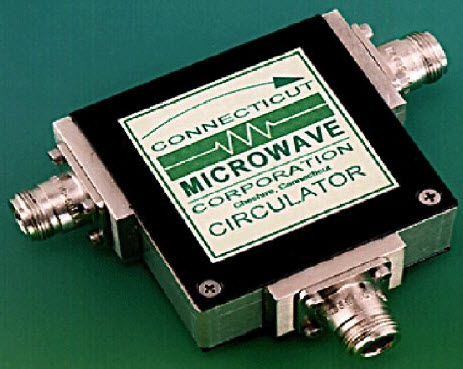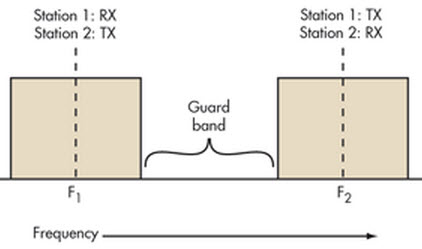Lighter, cheaper radio-wave device could double the useful bandwidth in wireless communications
November 14, 2014

University of Texas at Austin researchers have built a radio wave circulator that has the potential to double the useful bandwidth in wireless communications by enabling full-duplex functionality, allowing devices to transmit and receive signals on the same frequency band at the same time. (Credit: Illustrator Erik Zumalt, Cockrell School of Engineering at The University of Texas at Austin)
Researchers at the Cockrell School of Engineering at The University of Texas at Austin have developed a way to double the useful bandwidth in wireless communications by enabling full-duplex functionality in the same frequency band (channel).
“Full-duplex” refers to the ability to transmit and receive signals simultaneously, as in cell-phone conversations.
The new innovation is the creation of a magnetic-free radio wave “circulator” that could be used in cellphones and other wireless devices, as reported in Nature Physics.
Existing circulators can provide two-way communications on the same frequency channel, but they are not widely adopted because of the large size, weight and cost associated with using magnets and magnetic materials.
Freed from a reliance on magnetic effects, the new circulator has a much smaller footprint while also using less expensive and more common materials. These cost and size efficiencies could lead to the integration of circulators within cellphones and other microelectronic systems, resulting in substantially faster downloads, fewer dropped calls and significantly clearer communications.
The team of researchers, led by Associate Professor Andrea Alu, has developed a prototype circulator that is 2 centimeters in size — more than 75 times smaller than the wavelength of operation. The circulator may be further scaled down to as small as a few microns, according to the researchers. The design is based on materials widely used in integrated circuits such as gold, copper and silicon, making it easier to integrate in the circuit boards of modern communication devices.

Current bulky circulator design (credit: Connecticut Microwave Corporation)
The researchers’ device works by mimicking the way magnetic materials break the symmetry in wave transmission between two points in space, a critical function that allows magnetic circulators to selectively route radio waves.
With the new circulator, the researchers accomplish the same effect, but they replaced the magnetic bias with a traveling wave spinning around the device.
The new circulator can also be tuned in real time over a broad range of frequencies, a major advantage over conventional circulators.
For telecommunications companies, which pay for licenses to use frequencies allotted by the U.S. Federal Communications Commission, a more efficient use of the limited available bandwidth means significant cost advantages. And because the design of the circulator is scalable and capable of circuit integration, it can potentially be placed in wireless devices.

Separate frequency bands used for current cell phones (TX: transmit; RX: receive) (credit: Electronic Design)
The circulator also could benefit other industries that currently use magnetic-based circulators. For instance, circulators used in phased arrays and radar systems for aircraft, ships and satellites can be extremely heavy and large, so minimizing the size of these systems could provide significant savings.
“We are also bringing this paradigm to other areas of science and technology,” Alu said. “Our research team is working on using this concept to protect lasers and to create integrated nano-photonic circuits that route light signals instead of radio waves in preferred directions.”
This research was supported by the Defense Threat Reduction Agency and the Air Force Office of Scientific Research.
Abstract of Magnetic-free non-reciprocity and isolation based on parametrically modulated coupled-resonator loops
Non-reciprocal components, which are essential to many modern communication systems, are almost exclusively based on magneto-optical materials, severely limiting their applicability. A practical and inexpensive route to magnetic-free non-reciprocity could revolutionize radio-frequency and nanophotonic communication networks. Angular-momentum biasing was recently proposed as a means of realizing isolation for sound waves travelling in a rotating medium1, and envisaged as a path towards compact, linear integrated non-reciprocal electromagnetic components2, 3. Inspired by this concept, here we demonstrate a subwavelength, linear radio-frequency non-reciprocal circulator free from magnetic materials and bias. The scheme is based on the parametric modulation of three identical, strongly and symmetrically coupled resonators. Their resonant frequencies are modulated by external signals with the same amplitude and a relative phase difference of 120°, imparting an effective electronic angular momentum to the system. We observe giant non-reciprocity, with up to six orders of magnitude difference in transmission for opposite directions. Furthermore, the device topology is tunable in real time, and can be directly embedded in a conventional integrated circuit.